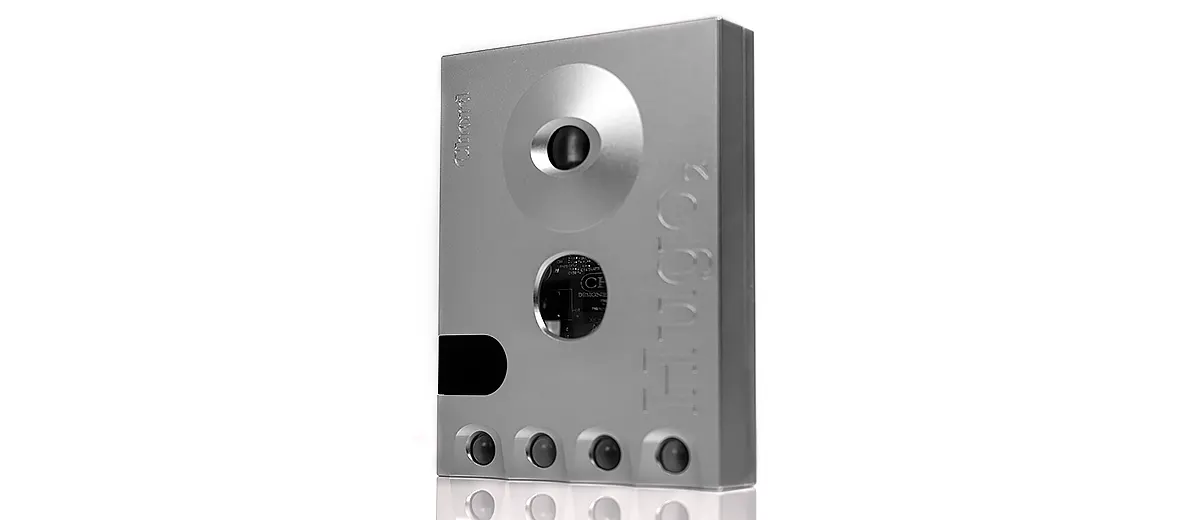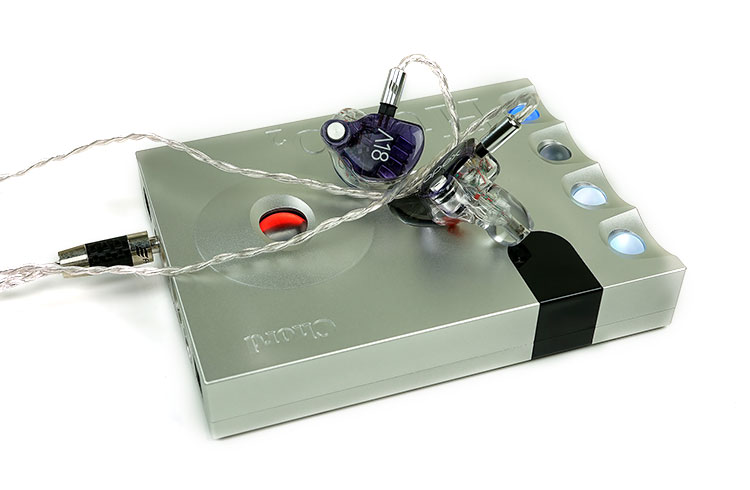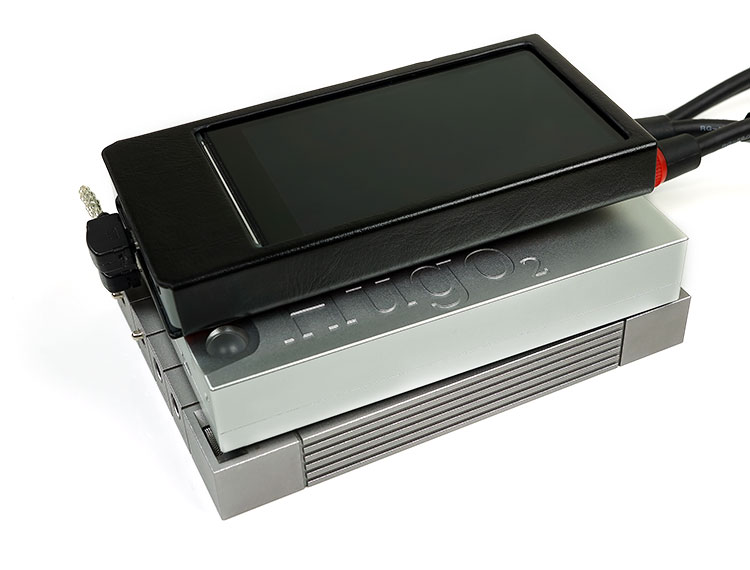Sound Impressions
Summary
The Hugo 2 has an incredibly coherent response and when stacked up against the Hugo 1 you get a much better sense of balance in the overall presentation. Nothing stands out as being overly colored or emphasized yet the detail and clarity have gone up a notch.
You could argue that the response is largely neutral but I would say there is a slight bias to a more natural sound with a smoother attack, particularly in bass and treble which is a lot more refined than before.
Certainly, the levels of transparency are much better on the Hugo 2 and in comparison to the Hugo 1 the level of accuracy in both instrumental timbre, speed, and control is more convincing and involving.
The older Hugo’s coloration always had this knack of drawing you into certain aspects of the performance at the cost of some other areas with bass and vocals to the fore and a slight smoothing of lower mids some way behind.
Not so on the Hugo 2 where clarity and detail in these areas are now much superior and a little bit more engaging.
Bass
The bass response is now more linear on the Hugo 2 with superior texture and detail compared to the more excitable but looser low-end of the Hugo 1.
The bass signature on the Hugo 1 comes across as a bit warmer, perhaps fuller-sounding but also softer and not quite as well defined or accurate sounding as the Hugo 2.
The additional bloom and a slightly thicker more elevated mid-bass of the Hugo 1 do make it the more “musical” of the two but if you listen carefully the Hugo 2’s low-end is the tighter and quicker of the two.
That linear more neutral positioning also affords a bit more space and focus on the Hugo 2’s presentation of lower-pitched instrumental notes. The nuanced detail on double bass and cello plucks from E1 up are cleaner and more palatable to the ear.
Mids
The Hugo 1 has a bit more in terms of lower mids warmth so it sounds a little less defined and softer than the Hugo 2 level of detail and control. As such, I tended to miss a little bit in terms of instrumental complexity and instead focused more on vocals, upper mids, and bass with the Hugo 1.
By comparison, instrumental separation and imaging are a bit cleaner and more precise on the Hugo 2. That lowering of the previous Hugo’s warmth and going instead with a more linear response on the Hugo 2 makes a big difference, particularly for complex guitar, bass guitar, or lower string clarity.
Vocals
Vocals are more neutral in both their tonality and positioning on the Hugo 2. The Hugo 1 vocals sound a little bit more vivid or forward-sounding. They grab your attention quicker but they also sound a little harder-edged and less forgiving by comparison.
Timbre
I always felt odd harmonics had a bit more emphasis when speaking about the timbre on Hugo 1. Engineering quirks on vocals that digitize and use autotune, especially on note attacks, will sound sharper with the Hugo 1 when played alongside the Hugo 2.
The harmonics balance is just that little bit better on the Hugo 2 so even if the recording is sharp it doesn’t amplify quite as much as the Hugo 1 which tends to throw out some sharper partial overtones. Overall, a slightly smoother and more natural-sounding timbre on the Hugo 2.
Treble
The top end of Hugo 1, though articulate and lively, has a slightly harder edge to the lower treble performance compared to Hugo 2. The Hugo 2 has a more natural-sounding top end and a little easier on the ear.
The Hugo 2 treble is also more articulate and delivers a more confident level of nuanced detail right up its brilliance response making it the more balanced sounding of the two with greater headroom and a little more air.
Synergy
You will probably notice that I have omitted to discuss any amp stage specs of the Hugo 2 up until this point. It is not an omission rather it’s an acknowledgment of the fact Chord designed the Hugo 2 without any traditional amping stage (opamp, buffer, gain, etc).
Rob Watt’s offers a detailed explanation of how the Hugo 2 works specifically for amplification:
The FPGA creates the digital signals to be fed into the pulse array discrete DAC. A flip-flop is a synchronous 1 bit memory device. The output will take the value of the input (in this case) on a rising edge of the clock. So why do I use flip-flops? Two basic reasons:
1. The output from an FPGA has a lot of signal correlated and random jitter on the pulse array waveforms. Putting it through a flip-flop removes the jitter to an insignificant level (confirmed through measurement).
2. The output from the FPGA is very noisy – using a flip-flop you eliminate the FPGA noise, and you are left with the noise on the flip-flop’s power supply – and this is designed to be extraordinary low noise (0.3uV) and extremely low impedance (0.0005 ohms – if this was a power amp it would be a damping factor of 16,000).
This ultra low impedance is essential to remove reference induced distortion, and amplitude modulation (AM) from the music envelope from changing the gain of the system. Music envelope AM is very damaging to the sound quality, particularly with bass perception.
So they flip-flop together with the reference supply, means we have a extremely low noise and jitter. The analogue section is just a single stage amp, coupled via individual resistors from each flip-flop.
Channel Balance
A few things arise out of this specific design. The first is that there is no analog volume control, it is entirely digital which means channel imbalance and other associated analog design quirks do not exist on the Hugo 2.
Whether you use a Campfire Andromeda, AKG K812, or an RHA CL1 you will get a clean and steady voltage control and volume rise without any channel bias on low volumes.
Noise Performance
The second is the performance specs of the Hugo 2 making this one heck of a dynamic range and good low noise performer on all but the most sensitive of IEMs.
You will detect a little bit of background hiss with the like of the Andromeda so it is not completely silent and less so than the Aurender Flow and marginally higher than the Mojo.
However, the Flow picks up a little more RF than the Hugo 2 (Hugo is not RF-free though) on OTG, something I think the Chord learned a lot from the Mojo RF feedback using smartphones.
Impedance
Output impedance on the Hugo 2 is low at 0.025Ω which significantly contributes to that lack of coloration in its tonality. It won’t suck out the bass on your sensitive BA configs nor will it dramatically alter the inherent tone of whatever you plug into it.
As a point of reference, the output impedance is even lower than the Mojo at 0.075Ω, more competitive than the Aurender Flow at 0.06Ω, and we have to assume far more accurate and lower than the Continental Dual Mono at < 1 Ohm.
I picked these ones out specifically because they are all in that same portable/transportable DAC/Amp class as the Hugo 2.
Output Power
At the same time, the output ratings under loads are excellent for a transportable DAC/Amp at 740mW for 32Ω loads and just over 1W for 8Ω.
For higher impedance and ultra-inefficient headphones, I would recommend using the Hugo 2 as a DAC and plugging it into a more powerful desktop amp such as the Cayin iHA-6 and its 7W output capability.
As a point of comparison, the Hugo 2 dwarfs similar class devices such as the Continental Dual Mono which can only manage 80mW single and 125mW balanced into 32 ohms and spanks the Flow’s 380 mW/32 ohms. The Mojo comes a lot closer at 600mW into 32 ohms which is excellent given its size.
Headphones & IEMs
Primarily for heavy-duty headphones such as the Hifiman HE-6 and Susvara using the Hugo 2 as a DAC line level out to a dedicated desktop amp is ideal.
Modern planars such as the LCD-2, Ether, and Ether Flow, however, have no driving issues paired with the Hugo 2. All have excellent dynamics and detail and none of them sound short of power.
Having said that users of the RHA CL1 150 ohm monster, as well as the power-hungry Vega and Flares Pro, will be particularly delighted with the performance of the Hugo 2.
It presents no issues on voltage control as well as driving these DD designs with maximum ease. Possibly some of the best pairings I have heard to date for clarity and timing.
Digital Only
The final point is the lack of analog inputs. Much like the Hugo 1 and Mojo the FPGA design and lack of an analog amplification stage independent of the DAC means there is no capability to pick up on an analog signal and output it directly on the Hugo 2. Everything coming in must be digital.
This means in terms of matchability you cannot pair another source a line out to the Hugo 2, it must be OTG, optical or coaxial, and Bluetooth.
Analog Out (Dual RCA)
Default Output
The analog output of the Hugo 2 is excellent and one of the best in its category. However, comparing the voltage line out of the Hugo 2 to some of its competitors and even some desktop units you can see that the Hugo 2’s line out Vrms is the same as the Mojo at 3Vrms.
Adjusting and Matching
Desktop units such as the Oppo Sonica DAC, Cayin iDAC-6, CDM, and DAC-1 from NuPrime all float between 2Vrms and 2.4Vrms so this is a touch higher than the norm.
You can opt to reduce the line-out Vrms rating in the same manner as the Mojo to whatever level you wish below 3Vrms if the response on your amp is a bit “too lively”.
You can also go even higher to almost 5Vrms before clipping with the pure white or final color code on the volume control.
Color Coordination
Your only problem with that is the linear control of the voltage on the Hugo is not as precise as the stepped control of the Mojo. Four clicks on the Mojo get you 1.9V which is good enough.
On the Hugo 2, it’s more of an estimation based on the color scheme relative to the Violet coding of the 3V default. My best guess is dark green to blue for 2V then fine-tune until you are happy with the output on your amp.
Bluetooth
BT range has effectively doubled over the original Hugo 1 in our testing. It just about hits the default range we normally aim for with dedicated smartphone BT receivers though it is a touch shorter with some DAPs.
Not so much a reflection of the Hugo 2 BT capability but more to do with the strength of the BT receivers on individual sources. In this test case, we got around 5-8m with one wall barrier between myself and the source.
That being said it is a touch fussier than the BT signal from the DX200 and X7iii and is more prone to ‘line of sight’ barrier drop-out but overall, it is a vastly superior experience to the first-gen Hugo which dropped out around 2 meters away with no barrier.





